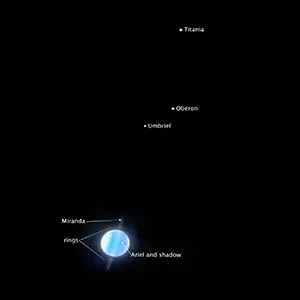
Strange surface patterns found on Uranus' moons surprise astronomers
Astronomers expected to see radiation-blasted scars on the sides of Uranus’ biggest moons that trail one after the other in orbit. Instead, they found darker patches on the moon faces that plow forward.
The mismatch hints at unseen dust streams and a surprisingly quiet magnetosphere around the tipped-over planet.
Working with NASA’s Hubble Space Telescope, a team of scientists led by Johns Hopkins University examined the moons Ariel, Umbriel, Titania, and Oberon.
The results, which were presented at the 246th American Astronomical Society meeting, overturn decades of predictions and add another twist to the solar system’s strangest giant.
Hubble’s ultraviolet vision made the discovery possible. Future observations with the James Webb Space Telescope will help clarify what is happening on and around these icy worlds.
Uranus’ moons show strange patterns
The four moons are tidally locked. Each always shows the same face to Uranus as it circles the planet once every few Earth days.
Scientists assumed that charged particles trapped in Uranus’ magnetic field would slam into the trailing hemispheres, darkening those regions through radiation chemistry.
Instead, the new images revealed almost no difference on Ariel and Umbriel and a clear leading-side darkening on Titania and Oberon.
“Uranus is weird, so it’s always been uncertain how much the magnetic field actually interacts with its satellites,” explained principal investigator Richard Cartwright, an astronomer at Johns Hopkins. “For starters, it is tilted by 98 degrees relative to the ecliptic.”
The planet rolls around the Sun on its side, and its magnetic field tilts a further 59 degrees from the plane in which the moons orbit.
“At the time of the Voyager 2 flyby, the magnetosphere of Uranus was tilted by about 59 degrees from the orbital plane of the satellites. So, there’s an additional tilt to the magnetic field,” Cartwright said.
Tilted magnetic puzzle
Because the magnetic field spins faster than the moons move, it was reasonable to think that the trapped particles would sandblast the trailing faces.
The fresh data show otherwise, suggesting the field either misses the moons or interacts in ways that leave little surface trace.

Charged particles and cosmic rays should still strike the moons from time to time. They can turn surface ice reddish and manufacture carbon dioxide that near-infrared telescopes detect.
Yet Ariel and Umbriel display nearly identical brightness on both hemispheres, while Titania and Oberon show the opposite of what the magnetospheric model predicted. Something else must be reshaping their leading sides.
Uranus’ moons hit by dust
The research team points to drifting debris as the likely culprit. Uranus has a collection of small, irregular satellites on wide, inclined paths.
Tiny meteoroids constantly pelt those bodies, ejecting plumes of dust that spiral slowly toward the planet.
Over millions of years the grains drift inward and intersect the orbits of Titania and Oberon. Like a car windshield gathering insects on a highway, the moons around Uranus scoop up the drifting dust on their forward-facing hemispheres.
“We see the same thing happening in the Saturn system and probably the Jupiter system as well,” said co-investigator Bryan Holler, an astrophysicist at the University of Colorado Boulder.
“So that supports a different explanation,” Cartwright added. “That’s dust collection. I didn’t even expect to get into that hypothesis, but you know, data always surprise you.”
Because Titania and Oberon orbit farther out, they sweep through the dust cloud first and act as shields. Ariel and Umbriel, tucked closer to Uranus, remain largely untouched, explaining their nearly uniform surfaces.
Hubble spots icy details
All of the brightness measurements came from Hubble’s Space Telescope Imaging Spectrograph, which can isolate faint ultraviolet signatures that are invisible to ground-based observatories.
“Hubble, with its ultraviolet capabilities, is the only facility that could test our hypothesis,” said team member Christian Soto, who performed much of the data extraction and analysis at the Space Telescope Science Institute.
The results suggest that Uranus’ magnetic bubble may be calmer – or more complex – than scientists believed.
Interactions could still occur without leaving distinct dark-to-bright contrasts, perhaps because the magnetic field lines skim past the moons in unexpected ways.
Untangling that puzzle will require more data, including infrared spectra from Webb that can identify surface ices and any dust coatings in detail.
Studying Uranus year-round
The findings force researchers to rethink how magnetospheres shape the surfaces of icy satellites. The study also shows that even well-trodden theories can fail when fresh observations arrive.
Future campaigns will target Uranus’ irregular moons to map the dust source and will watch the giant planet through different seasons to track changes in its tilted field.
For now, the moons around Uranus carry the dusty fingerprints of a slow but relentless process that Hubble was uniquely poised to see.
In a system famous for breaking the rules, another cosmic curveball has landed – one that turns leading faces into bug-splattered windshields and leaves trailing sides curiously unscathed.
—–
Like what you read? Subscribe to our newsletter for engaging articles, exclusive content, and the latest updates.
Check us out on EarthSnap, a free app brought to you by Eric Ralls and Earth.com.
—–













